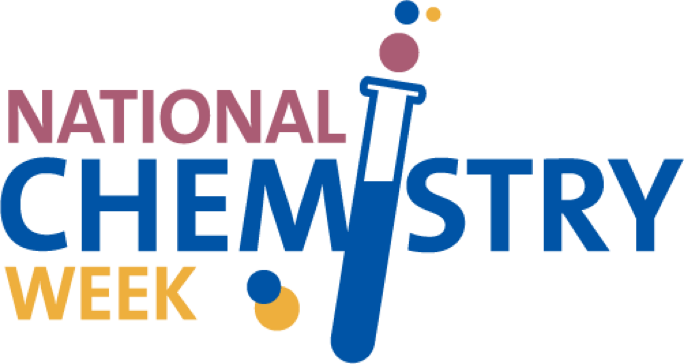Celebrating Chemistry NCW 2020
Sticking with Chemistry
Welcome to the sticky chemistry of glues and adhesives!
An adhesive is something used to stick things together. Adhesives are all around us, although sometimes hidden from our sight … or so obvious we don’t notice them. For example, look around your kitchen. You may see bottles, jars, and cans with informative labels stuck to them, or food packages like cereal boxes that are sealed tight with glue. If you look down, you’ll see your shoes, which are probably held together partly with adhesive chemicals. There are all sorts of adhesives for different uses and they stick in many different ways.
So, what makes something stick? Two basic forces involved in sticking one thing to another are adhesion and cohesion. Adhesion is a force that causes different things to stick together, while cohesion is the force that causes similar things to stick together.
You can see both of these forces at work when you look at a water droplet. If you dip your finger in a glass of water and then pull it, out several drops will fall into the glass. But the last one will stick to the end of your finger. This is an example of adhesion. The water also sticks to itself, forming the round drops due to cohesion. But both the adhesion and cohesion in water are very weak, so it’s not a very good adhesive.
Another key part of something sticking is wetting, which is how much the adhesive flows and gets into the tiny parts (rough surface) of what you are trying to stick it to. When you press a Band-Aid bandage to your skin, you make the sticky molecules flow a tiny bit into the rough surface of your skin, and the whole thing sticks to you!
The interesting past of paste
Humans have been using adhesives for a long time. Natural adhesives made from sticky tree sap and animal products, such as skin and cartilage, have been used since ancient times. Adhesives have even been found in the tombs of the ancient pharaohs in Egypt!
Over the last 100 years, chemists have developed stronger synthetic adhesives for all sorts of applications. Scientists need to design adhesives with different stickiness, depending on their use. For example, think about a Band-Aid. The adhesive needs to be able to stick to both the plastic of the Band-Aid, and also to you! It can’t stick too much, or you wouldn’t get it off!
Today we have a big variety of stickiness, from very strong adhesives like “superglue” to special, not-so-sticky adhesives used for Post-It notes or painter’s tape. Today, chemists are working to develop adhesives that work to replace stitches when you get cut, as well as adhesives that work underwater, in very hot environments, and even in outer space!
Stick with this edition of Celebrating Chemistry and learn about the development of the Post-It note, how chemists are being inspired by nature to make even better adhesives, how to make homemade glue, and how to test just how sticky tape is. Celebrate National Chemistry Week 2020 with the theme, “Sticking with Chemistry.” We hope that after reading through this edition of Celebrating Chemistry, you’ll be stuck on chemistry!
Dr. David Heroux is Associate Professor of Chemistry at Saint Michael’s College in Colchester, VT.
About this Issue of Celebrating Chemistry
Production Team
- Allison Tau, Editor
- Eric Stewart, Copyeditor
- Michael Tinnesand, Copyeditor
- Rhonda Saunders, Designer
- Jim Starr, Illustrator
- Beatriz Hernandez, Translator
Technical and Safety Review Team
- Lynn Hogue, Consultant
- Bettyann Howson, Safety Reviewer
- David A. Katz, Safety Reviewer
- Ashley Neybert, Accessibility Reviewer
- Ingrid Montes, Translation Reviewer
Division of Education
- LaTrease Garrison, Executive Vice President
- Lily L. Raines, Manager, Science Outreach
- Allison Tau, Program Specialist, Science Outreach
NCW 2020 Theme Team
- Lori Stepan, NCW Chair
- An-Phong Le, 2020 Co-Chair
- Alexsa Silva, 2020 Co-Chair
- Janet Asper
- William Doria
- Miranda J. Gallagher
- David Heroux
- Veronica Jaramillo
- Keith Krise
- Avrom Litin
- Alex Madonik
- Monica Sekharan
Acknowledgments
The articles and activities used in this publication were written by theme team members of the ACS Committee on Community Activities (CCA) under the leadership of Holly Davis. Meg A. Mole’s interview was written by Kara KasaKaitas. ACS would like to acknowledge editorial contributions from the Long Research Group at Virginia Tech and the Adhesion Society.
The activities described in this publication are intended for children under the direct supervision of adults. The American Chemical Society cannot be responsible for any accidents or injuries that may result from conducting the activities without proper supervision, from not specifically following directions, or from ignoring the cautions contained in the text.
IN THIS ISSUE
WORDS TO KNOW
Adhesion – different things sticking together.
Adhesive – stuff used to stick two things together.
Cohesion – bonding that holds one kind of stuff together.
Glue – sticky liquid with adhesive dissolved in a solvent.
Molecule – the smallest unit of a chemical compound.
Tape – plastic or paper strip with a solid adhesive on one side.
Wetting – to cover a surface with water or any other liquid.


